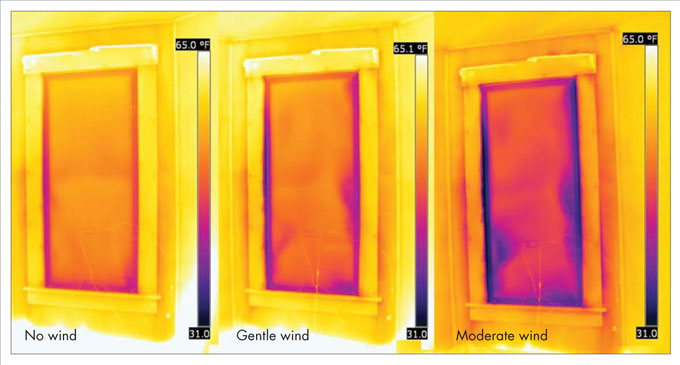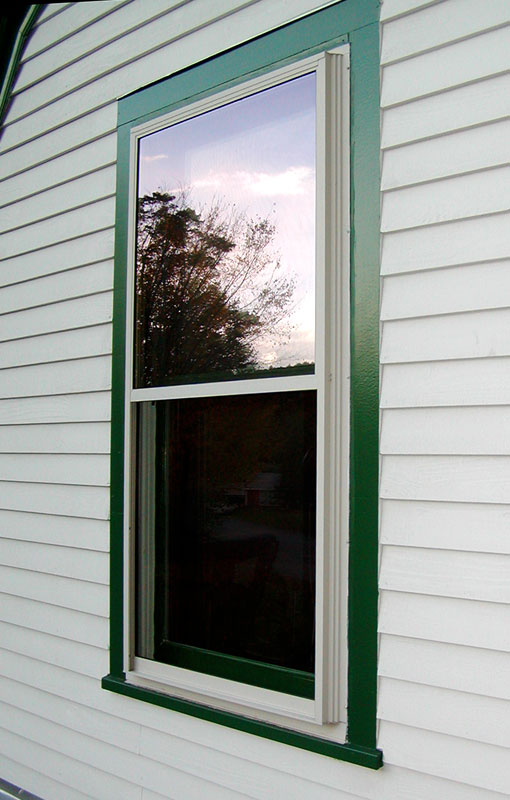I am working on a historic project where we are replacing factory-style windows and hoping to get better performance out of our glazing. The replacement windows will be single-pane, (unfortunately from an energy perspective), but we are targeting IECC 2009 compliance for New Orleans, which means a SHGC of 0.30 and u-factor of 0.65.
Anyone know of any products, film or factory applied, that could help us bring single-pane glazing to this performance? It's looking tricky, likely reflective, 80's style appearance if we can reach those targets.
Thanks!
Blog Post
Improving Your Windows with Plastic Film Kits, Insulated Shades, and Interior Storm Windows

Try this little perceptual experiment now: look at yourself in a mirror (or your computer or phone camera). Then look at your left eye, and then your right eye, and then back and forth several times. What do you see?
If someone else is around, ask them to look at you, and look back and forth between your eyes.
What do you see? When you're looking at someone else moving their eyes back and forth, that's exactly what you see. But when you look at yourself in the mirror, you never see your eyes move. When I do this, I can see that my eyes are at a slightly different angle, and I can feel a tiny break in the string of perception when moving them, but I can never see my eyes move.
Why not? The best explanation that I have heard (and please email me if you have a better one) is that while we think of our experience as an uninterrupted "movie," that movie is actually composed of many tiny "clips," and our brains very often fill in missing details between clips. In this case, our brains are unable to see our own eyes moving while they are moving, so the short gap in perception is smoothed over as we watch the "movie."
It's time to check windows for winter-readiness
With the weather this hot, it's hard to imagine that we would ever want to try to keep it in the building. (If you're still more focused on keeping heat out of your windows, check out last week's post.) But check your memory from January or so, and you may realize that we can't skip over a whole season, and that now is the time to get ready for this winter by checking your windows and seeing if any modifications can help them keep you warmer when the time comes.
SUPPORT INDEPENDENT SUSTAINABILITY REPORTING
BuildingGreen relies on our premium members, not on advertisers. Help make our work possible.
See membership options »Winter window attachments use one of two methods to keep heat in: adding insulation to the window assembly, or improving airtightness.
Boosting window R-value is not that hard with kits
If you're stuck with single-pane or other poorly insulated windows, there is hope: you can boost their R-value and slow down air leakage by covering up the whole window assembly with another layer of plastic or glass. The best products perform almost as well as high-end replacement windows and tend to have a lower price tag. A box of clear plastic and double-sided tape is the least expensive and most widely available window attachment--and the performance isn't too shabby. These kits, commonly found at hardware stores, provide modest insulation (adding an R-value of about 1), significantly reduce air leakage, and improve comfort by adding a layer between cold glass and warm rooms. They also help prevent condensation, and both renters and homeowners can install them cost-effectively.
Insulated shades add up to R-4, but watch your seals
If you don't like to look at the film kits, or if you don't like loosing paint when you take them down, you might prefer the benefits of conventional fabric window coverings and interior shades, which increase comfort by adding a warmer layer between the cold window glass and the heated room.
Conventional insulated shades improve R-value by 1–2, but higher-performing shades with side tracks improve R-value by up to 4! These products include cellular shades and "window quilts" that fit snugly to the window trim with side tracks or other fasteners. The shades need to be completely closed in order to provide the full thermal benefit.
If you have insulated shades and double-glazed windows, be careful in the summer. If insulated shades are deployed on a hot, sunny day on south- and west-facing windows, preliminary research indicates that overheating may occur: some modeled temperatures have gone above 200° F (93° C), which could damage seals and shorten the expected window life. Finding other ways to control glare and solar gain on south-facing low-e windows, such as awnings or conventional curtains, is probably a good idea until more is known.
Interior window panels offer several benefits

Fixed interior window panels (widely called "interior storm windows" even though they do not protect windows from the weather) offer unobtrusive high performance starting at a relatively low price and are especially popular in places where exterior storm windows won't work--in historic homes, condominiums, long-term rental properties, and on dangerously high windows.
They are made of plastic or glass--sometimes even low-e glass, which costs more--and come with different framing materials (most commonly aluminum). Some have operable parts and can remain in place year-round, but most have to be removed seasonally; this is the main drawback of interior panels, as they can block emergency exits through the window and also require space for safe storage.
Low-e interior window panels offer a number of benefits when properly installed. They improve R-value by about 2, increase comfort by creating a barrier between the cold window glass and the room, and do a pretty good job of sealing air leaks; the tight seal on the interior also helps reduce condensation by preventing warm, moist indoor air from entering the window assembly and being chilled by the air near the cold glass. Low-e versions have a radiant barrier that further reduces heat loss, bringing the entire window assembly almost up to par with low-e double-pane replacement windows.
Costs will vary hugely
As with window attachments for keeping heat out, Costs of window attachments vary hugely. Film kits are cheap, while other options go up in price--but are often less expensive than replacing a window that's not working for you. Check WindowAttachments.org for some great fact sheets on individual options and comparative costs. My colleague Peter Yost also offers a really insightful case study on getting the most of the windows in his house.
With my other colleague Paula Melton, Peter authored Making Windows Work Better, the recent feature article from Environmental Building News, from where I borrowed a lot of today's advice.
Do you have windows that aren't quite working for you, but you aren't quite sure how to handle them? Other questions or comments? Post them below.
Image information: Top image (credit LBNL): Lawrence Berkeley National Laboratory used infrared (IR) imaging as part of its field testing for ongoing research on the energy performance of window attachments. These three photos show the same window, with an interior low-e panel attached, under three different pressure conditions simulating windy weather. Even with a fairly tightly sealed interior window panel, the moderate wind level significantly increases air leakage. Note that each IR image encompasses the same temperature range--a critical detail when doing side-by-side comparisons. Lower image (credit Peter Yost): Low-e storm windows can bring the performance of single-pane windows up to par with low-e double-pane models. As an exterior device, these attachments may not be accepted in some historic areas or condominium communities. Low-e interior panels are a good option in these situations.
Published August 3, 2011 Permalink Citation
(2011, August 3). Improving Your Windows with Plastic Film Kits, Insulated Shades, and Interior Storm Windows. Retrieved from https://www.buildinggreen.com/news-article/improving-your-windows-plastic-film-kits-insulated-shades-and-interior-storm-windows
Comments
Single Pane SHGC and U-value performance with film
seeking non-vinyl transparent
seeking non-vinyl transparent economical window film for making my own winserts. Mylar? other? any info appreciated
Can you illustrate an example
Can you illustrate an example INTERIOR storm? I'm cuious about edge/millwork treatment. The one shown is EXTERIOR.
I fabricated very effective,
I fabricated very effective, very economical 'interior storms' for my historic house. Inside jambs were smooth & square, so I took careful measurements of width & height and cut 3/8" plexi sheets to 1/4" less than the inside dimension. I then applied self-stick closed-cell foam stripping all the way around the outside edge and eased the window into the opening where it is friction fit. A small wire hook can be inserted under the foam and rotated to engage the plexi for removal - simply pull gently. No fixed hardware and no fasteners makes this a low-impact, low-visibility solution for historic homes - for smaller windows only.




Add new comment
To post a comment, you need to register for a BuildingGreen Basic membership (free) or login to your existing profile.